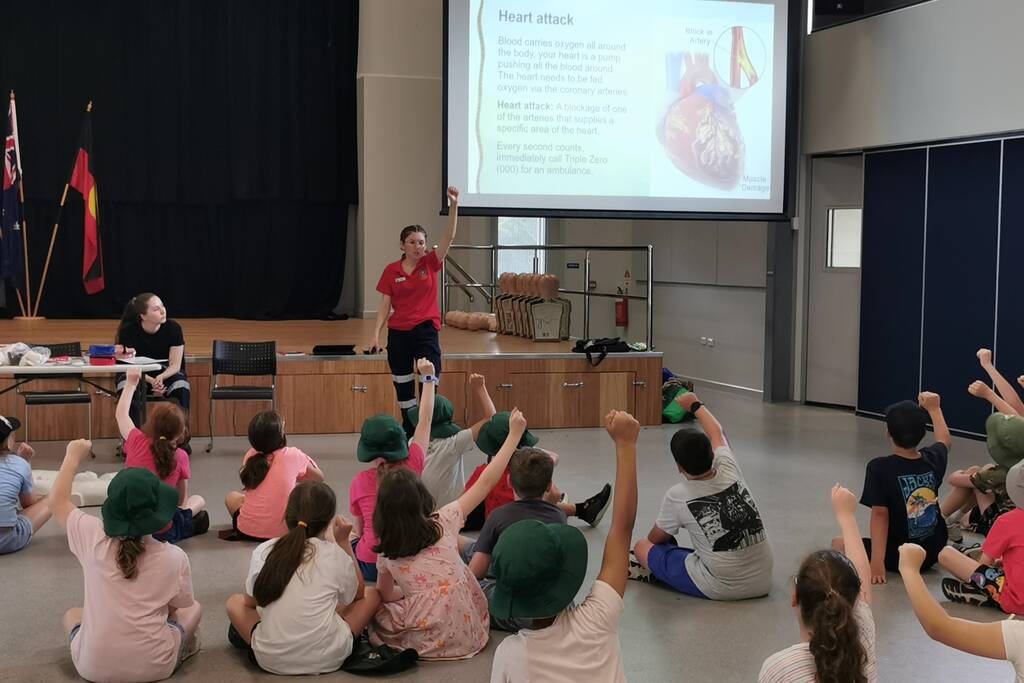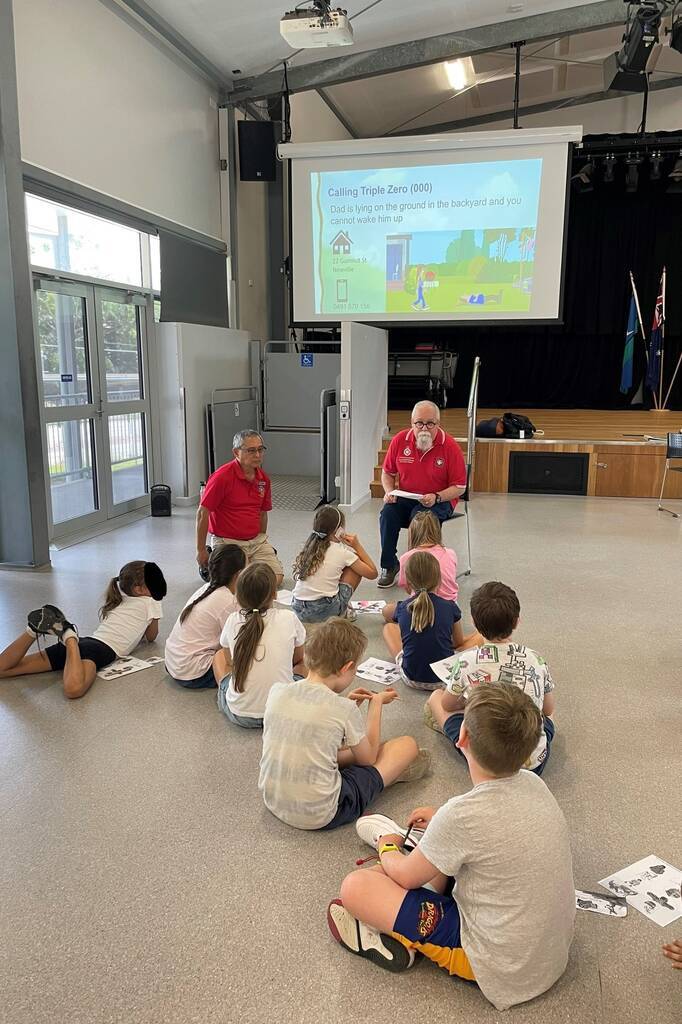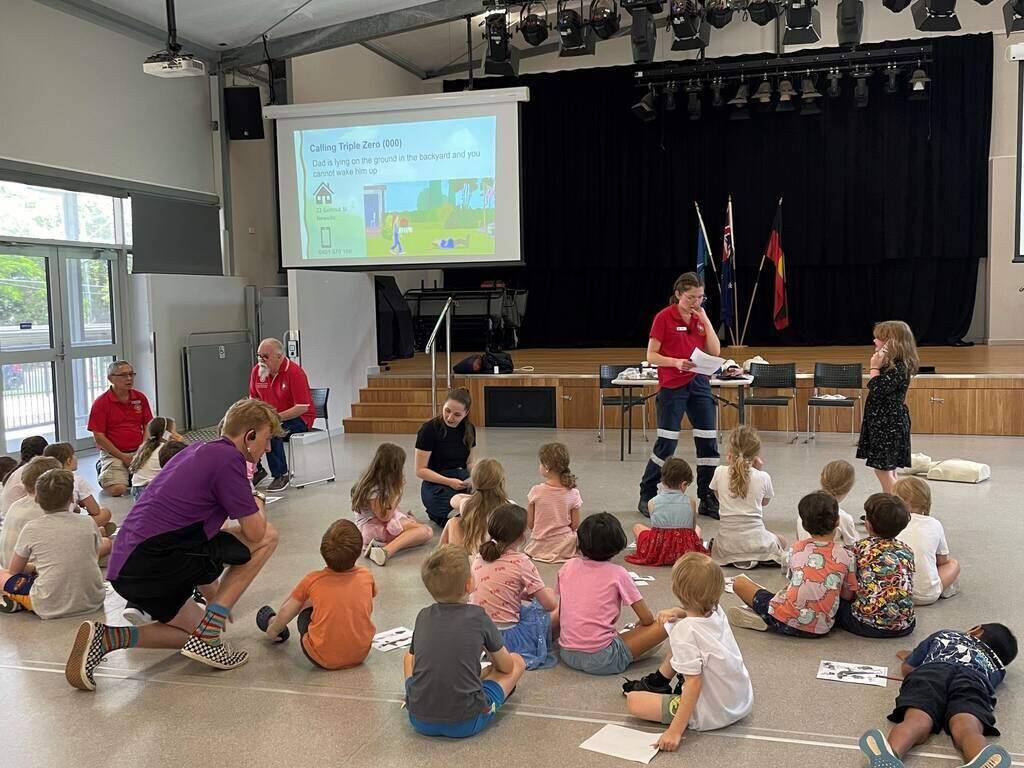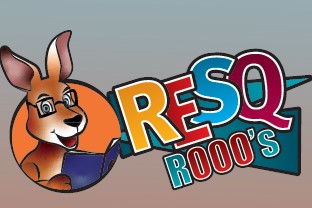
Chermside Local Ambulance Committee (LAC) volunteer and student paramedic Emily Bailey admitted she had a moment of fear and trepidation when she accepted a request for the LAC to deliver first aid training to around 60 primary school children at vacation care in early January.
While the LAC has delivered basic CPR and first aid awareness training sessions for children from local schools and community groups, this session was the first time Emily and the LAC team of volunteers would deliver the Queensland Ambulance Service’s (QAS) refreshed RESQ R000’s structured first aid course.
“Our brief was to provide this training course to students ranging in age from Pre-Prep to Year 6 (aged 4-11 years old) within a two-hour window,” Emily said.
“An initial concern I had was how we would keep such a large group of children of all ages engaged.
“We had an extensive planning session and collaborated with the Statewide Community Engagement Operational Supervisor Suzette Dakin, who works from the QAS Medical Director's Office.
“As a team we devised a plan which split the students into two groups so we could tailor the sessions’ content and interactive activities to ensure we kept the students interested and engaged for the whole time.
“Working with Suzette was inspiring as she is so passionate and knowledgeable about community engagement, and we really appreciated her support and guidance throughout this process.”
Emily said another challenge the team faced was ensuring it had enough volunteers available on the day.
“We ended up with an amazing team of LAC volunteers on the day; four Chermside LAC members including President Dayle Joekong, as well as Maleny LAC’s President and retired paramedic, Ken Nipperess.
“Aside from delivering the education session, it was wonderful to collaborate with another LAC and discuss their community education programs and experience.”
 The team delivered five units of RESQ R000’s training to the Pre-Prep to Year 3 group, which included providing contact details, identifying an emergency and recognising and controlling bleeding.
The team delivered five units of RESQ R000’s training to the Pre-Prep to Year 3 group, which included providing contact details, identifying an emergency and recognising and controlling bleeding.
“These units were basic but they’re absolutely essential skills for children, and we also integrated hands-on activities within this content where the students practiced bandaging, placing their friends in recovery position and role-playing a call to triple zero,” said Emily.
“We delivered two more detailed units to the students in the Years 4-6 group, including how to perform cardiopulmonary resuscitation (CPR), some resuscitation variables such as fracturing ribs and airway clearance, and finally how to operate an AED.
“In this session we emphasised plenty of hands-on practice and time for questions, helping to consolidate learning which was entirely new for some of these students.”
The Gap State School’s Outside School Hours Care (OSHC) spokesperson Eliana Casey said student and parent feedback from this session was so positive the OSHC was keen to establish a regular annual training session for its young students to enable them to learn these skills for the first time, or to refresh them.
“We believe these skills are so useful as they give children and young people the tools to help others and potentially save lives, no matter their age,” Eliana said.
“Before the session when the students were arriving, we had a few parents tell us how excited they were about their children participating in such a useful incursion.
“We also had other parents tell us afterwards how pleased they were with the content covered during the incursion and what their children learnt.
“We were so incredibly thrilled with this program and the LAC team’s session,” Eliana said.
“Emily and the LAC volunteers were amazing to work with, and we’ll be recommending this program to our other YMCA OSHC centres for future vacation care incursions as we think this would benefit our other YMCA Centres and their students.”
Emily said she and the team were impressed with the children’s overall interest and enthusiastic engagement with the hands-on activities like CPR on the mannikins.
“When it was time for us to pack up, the students were still lining up to practice applying the AED and ask questions,” she said.
“It was also exciting to teach students a new skill and see them applying it, for example, successfully placing a person into recovery position.
“Seeing this progress in such a short time was amazing, and it reinforces the value of community education sessions and the feasibility of teaching basic first aid to students as young as four-years-old.”
Emily pointed out there had been numerous accounts of children as young as four who’d called Triple Zero (000) and commenced first aid during accidents or emergencies (Towers & Whybrow, 2018).
“As children can sometimes be the sole bystander during an emergency, it is essential we increase their awareness through programs like RESQ R000's,” she said.
“Our education session this month served to develop younger students’ knowledge, confidence and skills to potentially saving the lives of their friends, family or even those in the greater community.
“This session was a wonderful team effort that really captured the LAC objective of liaising between the community and QAS to deliver programs to build a community’s resilience when responding to emergencies.”
 Have you thought about volunteering?
Have you thought about volunteering?
LACs around the state welcome QAS staff as volunteers to help deliver CPR and first aid awareness training to our communities.
To find out more about RESQ R000's and other community education programs our LACs deliver, click here.